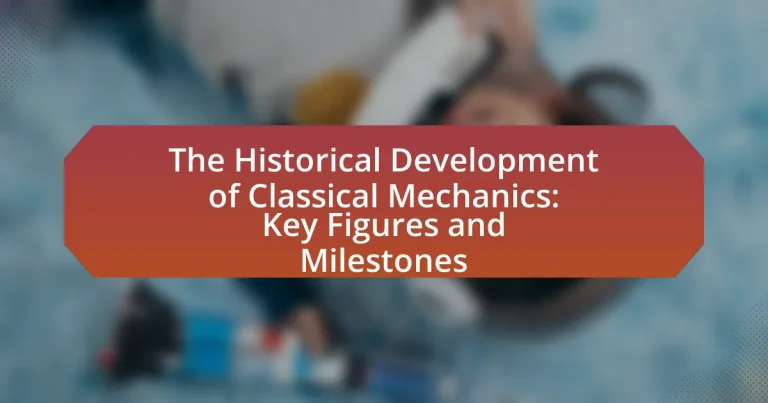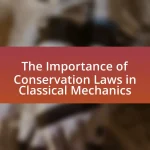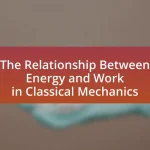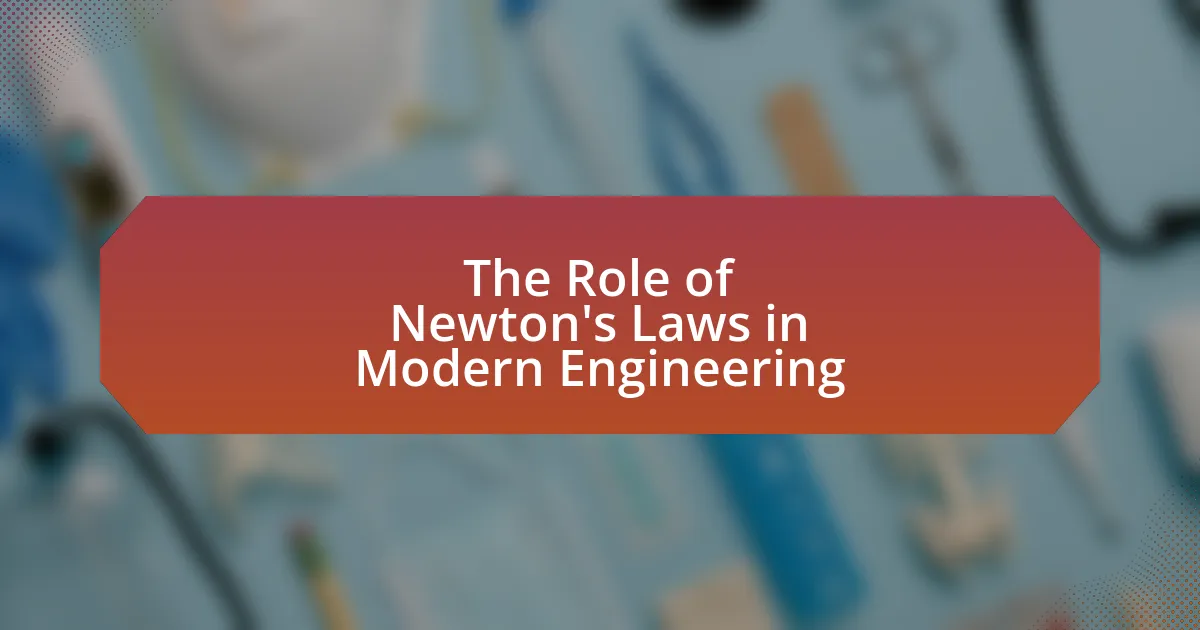The article examines the historical development of classical mechanics, highlighting key figures and milestones that shaped the field. It begins with the foundational concepts introduced by ancient Greek philosophers, progresses through the significant contributions of Galileo Galilei and Isaac Newton, and explores advancements made in the 18th and 19th centuries by scientists such as Euler and Lagrange. The article also discusses the societal influences on the evolution of classical mechanics, the impact of its principles on various scientific disciplines, and the transition to modern physics, emphasizing the lasting significance of classical mechanics in contemporary science and engineering practices.

What is the Historical Development of Classical Mechanics?
The historical development of classical mechanics began with ancient Greek philosophers, notably Aristotle, who proposed early concepts of motion and force around 350 BCE. This foundation was further advanced by Galileo Galilei in the late 16th and early 17th centuries, who conducted experiments that challenged Aristotelian physics and laid the groundwork for the scientific method. Isaac Newton’s publication of “Philosophiæ Naturalis Principia Mathematica” in 1687 marked a significant milestone, introducing the laws of motion and universal gravitation, which unified terrestrial and celestial mechanics. The 18th and 19th centuries saw further advancements through the work of figures like Leonhard Euler and Joseph-Louis Lagrange, who developed analytical mechanics, and James Clerk Maxwell, who integrated mechanics with electromagnetism. These contributions collectively established classical mechanics as a fundamental framework for understanding physical phenomena, influencing various scientific disciplines.
How did Classical Mechanics evolve over time?
Classical Mechanics evolved over time through significant contributions from key figures and milestones, beginning with ancient Greek philosophers and culminating in the formulation of Newtonian mechanics in the 17th century. Early ideas from Aristotle and Archimedes laid foundational concepts, but it was Isaac Newton’s “Philosophiæ Naturalis Principia Mathematica,” published in 1687, that established the laws of motion and universal gravitation, fundamentally shaping the field. Following Newton, the 18th and 19th centuries saw advancements from figures like Lagrange and Hamilton, who introduced analytical mechanics, further refining the mathematical framework. The evolution continued with the integration of thermodynamics and electromagnetism, leading to a more comprehensive understanding of physical phenomena. These developments collectively illustrate the progressive refinement and expansion of Classical Mechanics over centuries.
What were the key periods in the development of Classical Mechanics?
The key periods in the development of Classical Mechanics include the Ancient Greek period, the Renaissance, the Newtonian era, and the 19th century advancements. The Ancient Greek period, marked by figures like Aristotle and Archimedes, laid foundational concepts of motion and force. The Renaissance, featuring scientists such as Galileo, introduced experimental methods and kinematics. The Newtonian era, initiated by Isaac Newton’s “Principia Mathematica” in 1687, established the laws of motion and universal gravitation, fundamentally shaping Classical Mechanics. The 19th century saw further refinements and the development of thermodynamics and electromagnetism, expanding the scope of Classical Mechanics. Each of these periods contributed significantly to the understanding and formulation of physical laws governing motion and forces.
How did societal changes influence the evolution of Classical Mechanics?
Societal changes significantly influenced the evolution of Classical Mechanics by fostering an environment that encouraged scientific inquiry and technological advancement. The Renaissance, for instance, marked a shift towards empirical observation and experimentation, leading figures like Galileo Galilei to challenge Aristotelian physics and lay the groundwork for modern mechanics. The rise of the Scientific Revolution in the 17th century, characterized by increased patronage for scientific research and the establishment of scientific societies, further propelled the work of Isaac Newton, whose laws of motion and universal gravitation were products of this supportive societal context. Additionally, the Industrial Revolution created practical applications for Classical Mechanics, driving innovations in engineering and manufacturing, which in turn validated and expanded the theories developed by earlier scientists. These societal transformations not only provided the necessary resources and intellectual freedom for scientific exploration but also integrated mechanics into everyday life, solidifying its importance in both academic and practical realms.
Who are the key figures in the history of Classical Mechanics?
The key figures in the history of Classical Mechanics include Isaac Newton, Galileo Galilei, and Johannes Kepler. Isaac Newton is renowned for formulating the laws of motion and universal gravitation, which laid the foundation for classical mechanics in his work “Philosophiæ Naturalis Principia Mathematica” published in 1687. Galileo Galilei contributed significantly by establishing the principles of inertia and conducting experiments that demonstrated the laws of falling bodies. Johannes Kepler is known for his laws of planetary motion, which described the orbits of planets around the sun, providing crucial insights into celestial mechanics. These figures collectively shaped the framework of classical mechanics through their groundbreaking theories and discoveries.
What contributions did Isaac Newton make to Classical Mechanics?
Isaac Newton made foundational contributions to Classical Mechanics, primarily through his formulation of the three laws of motion. These laws describe the relationship between the motion of an object and the forces acting on it, establishing a framework for understanding dynamics. Newton’s first law, the law of inertia, states that an object at rest stays at rest and an object in motion continues in motion unless acted upon by a net external force. His second law quantifies this relationship with the equation F=ma, where force equals mass times acceleration, providing a method to calculate the effects of forces on motion. The third law states that for every action, there is an equal and opposite reaction, highlighting the interactions between objects. These principles were published in his work “Philosophiæ Naturalis Principia Mathematica” in 1687, which laid the groundwork for classical mechanics and influenced subsequent scientific thought and engineering practices.
How did Galileo Galilei’s work lay the groundwork for Classical Mechanics?
Galileo Galilei’s work laid the groundwork for Classical Mechanics by introducing the concepts of inertia and the uniform acceleration of falling bodies. He demonstrated that objects fall at the same rate regardless of their mass, which contradicted Aristotelian physics. Through experiments, such as rolling balls down inclined planes, Galileo quantified motion and established the principle of inertia, stating that an object in motion stays in motion unless acted upon by an external force. His formulation of the laws of motion and the mathematical description of acceleration provided a foundation for later physicists, including Isaac Newton, who built upon Galileo’s principles to develop the laws of motion and universal gravitation.
What milestones marked the advancement of Classical Mechanics?
The advancement of Classical Mechanics is marked by several key milestones, including the formulation of Newton’s laws of motion in the late 17th century, which established the foundation for classical physics. Isaac Newton’s “Philosophiæ Naturalis Principia Mathematica,” published in 1687, introduced the three laws of motion and the law of universal gravitation, fundamentally changing the understanding of motion and forces. Another significant milestone was the development of the calculus by Newton and Leibniz, which provided the mathematical tools necessary for analyzing motion. The 18th century saw further advancements with the work of figures like Euler and Lagrange, who contributed to the formulation of analytical mechanics, enhancing the mathematical framework of the discipline. The 19th century introduced thermodynamics and statistical mechanics, expanding the scope of classical mechanics to include heat and energy. Each of these milestones played a crucial role in shaping the principles and applications of Classical Mechanics as we understand them today.
What were the significant discoveries that shaped Classical Mechanics?
The significant discoveries that shaped Classical Mechanics include Newton’s laws of motion, the law of universal gravitation, and the principles of conservation of energy and momentum. Isaac Newton formulated the three laws of motion in his work “Philosophiæ Naturalis Principia Mathematica” published in 1687, which established the foundation for understanding the relationship between forces and motion. The law of universal gravitation, also proposed by Newton, describes the gravitational attraction between masses, providing a comprehensive explanation for planetary motion. Additionally, the principles of conservation of energy and momentum, developed through the works of various scientists including Galileo and later formalized by others, established critical frameworks for analyzing mechanical systems. These discoveries collectively laid the groundwork for Classical Mechanics, influencing countless advancements in physics and engineering.
How did the formulation of laws and principles impact the field?
The formulation of laws and principles significantly advanced the field of classical mechanics by providing a systematic framework for understanding motion and forces. For instance, Isaac Newton’s laws of motion, articulated in the 17th century, established foundational concepts such as inertia, acceleration, and action-reaction, which enabled scientists to predict the behavior of physical systems accurately. This structured approach facilitated the development of engineering and technology, as seen in the design of machinery and vehicles, which rely on these principles for functionality. The impact is evident in the widespread application of Newtonian mechanics in various domains, including astronomy, where it allowed for precise calculations of planetary orbits, and in everyday life, where it underpins the functioning of countless devices.
How did the transition from Classical to Modern Physics occur?
The transition from Classical to Modern Physics occurred through the introduction of revolutionary concepts that challenged classical mechanics, particularly in the late 19th and early 20th centuries. Key developments included the formulation of quantum mechanics by Max Planck and Albert Einstein, which addressed phenomena that classical physics could not explain, such as blackbody radiation and the photoelectric effect. Additionally, Albert Einstein’s theory of relativity fundamentally altered the understanding of space and time, demonstrating that they are interwoven rather than absolute. These advancements were validated through experimental evidence, such as the Michelson-Morley experiment, which failed to detect the ether, supporting the theory of relativity. The combination of these groundbreaking theories marked a significant paradigm shift, leading to the establishment of Modern Physics.
What role did Classical Mechanics play in the development of other scientific fields?
Classical Mechanics served as a foundational framework for the development of various scientific fields, including physics, engineering, and astronomy. Its principles, such as Newton’s laws of motion, provided essential tools for understanding motion and forces, which are critical in fields like engineering for designing structures and machines. Additionally, Classical Mechanics influenced the formulation of theories in thermodynamics and electromagnetism, as seen in the work of scientists like James Clerk Maxwell, who integrated mechanical concepts into his electromagnetic theory. The mathematical techniques developed in Classical Mechanics, such as calculus, also became integral to advancements in fields like economics and biology, facilitating the modeling of dynamic systems.
What are the lasting impacts of Classical Mechanics on contemporary science?
Classical Mechanics has profoundly influenced contemporary science by establishing foundational principles that govern motion and forces, which are essential in various fields such as engineering, astronomy, and physics. The laws formulated by Isaac Newton, particularly the laws of motion and universal gravitation, serve as the basis for modern mechanics and are integral to the design of structures, vehicles, and spacecraft. Furthermore, Classical Mechanics has paved the way for advancements in technologies like GPS and robotics, where precise calculations of motion are crucial. The mathematical frameworks developed during this period, including calculus, continue to be utilized in scientific research and applications today, demonstrating the enduring relevance of Classical Mechanics in shaping contemporary scientific understanding and technological innovation.
How does Classical Mechanics influence modern engineering practices?
Classical Mechanics significantly influences modern engineering practices by providing foundational principles that govern the behavior of physical systems. Engineers apply concepts such as Newton’s laws of motion, which describe how forces affect the motion of objects, to design structures, vehicles, and machinery. For instance, the analysis of forces and torques is essential in civil engineering for ensuring the stability of buildings and bridges. Additionally, the principles of energy conservation and momentum are utilized in mechanical engineering to optimize the performance of engines and mechanical systems. Historical milestones, such as Galileo’s studies on motion and Newton’s formulation of classical mechanics, established the mathematical frameworks that continue to underpin engineering calculations and simulations today.
What are the educational implications of studying Classical Mechanics today?
Studying Classical Mechanics today has significant educational implications, as it forms the foundation for understanding advanced scientific concepts and engineering principles. Classical Mechanics equips students with critical problem-solving skills and analytical thinking, essential for fields such as physics, engineering, and technology. Furthermore, it fosters an appreciation for the historical context of scientific development, highlighting contributions from key figures like Newton and Galileo, which can inspire future innovations. The principles of Classical Mechanics are also applicable in modern technologies, such as robotics and aerospace, reinforcing the relevance of this subject in contemporary education.
What practical insights can be gained from the history of Classical Mechanics?
The history of Classical Mechanics provides practical insights into the evolution of scientific thought and the development of technology. Key figures such as Isaac Newton established foundational principles, including the laws of motion and universal gravitation, which are essential for understanding the behavior of physical systems. These principles have practical applications in engineering, aerospace, and various fields of physics, demonstrating how historical advancements directly influence modern technology. For instance, Newton’s laws enable the design of vehicles and structures, illustrating the tangible benefits derived from Classical Mechanics. Additionally, the historical progression from Galileo’s experiments to Newton’s formulations highlights the importance of empirical evidence and mathematical modeling in scientific inquiry, which remains relevant in contemporary research and innovation.




